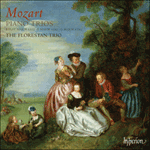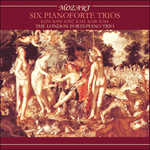
Welcome to Hyperion Records, a British classical label devoted to presenting high-quality recordings of music of all styles and from all periods from the twelfth century to the twenty-first.
Hyperion offers both CDs, and downloads in a number of formats. The site is also available in several languages.
Please use the dropdown buttons to set your preferred options, or use the checkbox to accept the defaults.

| The Florestan Trio» More |
Despite this new independence of the string parts, the B flat Trio has a particularly flamboyant character in its piano-writing which makes it seem almost like a concerto. The first-movement Allegro is constructed virtually throughout from the opening phrases, in which piano and stringed instruments answer each other—an economy of means that is much more characteristic of Haydn than of Mozart. Only at the start of the central development section does Mozart venture further afield, with a new theme first on violin then on cello. The Larghetto is a movement of highly decorated lyricism, with a simpler and more poised middle section. Again the style of the elaboration seems to suggest homage to Haydn. The finale is a wide-ranging rondo. Its opening phrase has a rather antique character, like a subject for an organ fugue. From time to time Mozart does treat it to ‘learned’ counterpoint, but always with his characteristically light touch, and interspersed with dashing passages of virtuoso piano-writing. These are combined in a brilliant way as the movement draws to a close. But it is the unassuming little second theme that ends the work, wittily played in counterpoint, as violin and cello answer each other like two characters vying to be the last to leave the stage.
from notes by Robert Philip © 2006
Mais cette nouvelle indépendance des cordes n’empêche pas le Trio en si bémol d’afficher une écriture pianistique particulièrement flamboyante, presque digne d’un concerto. Le premier mouvement Allegro repose presque entièrement sur les phrases d’ouverture, où piano et cordes se répondent mutuellement—une économie de moyens bien plus haydnienne que mozartienne—et c’est seulement au début de la section de développement central que Mozart ose davantage, avec un nouveau thème exposé au violon, puis au violoncelle. Le Larghetto, d’un lyrisme fort orné, présente une section médiane plus simple et plus posée. Là encore le style de l’élaboration semble suggérer un hommage à Haydn. Le finale est un ample rondo, avec une phrase d’ouverture plutôt antique, comme un sujet de fugue pour orgue. Mozart la traite parfois selon un contrepoint «savant», mais sans se départir de sa légèreté caractéristique et en l’émaillant d’éblouissants passages pianistiques virtuoses, brillamment combinés vers la fin du mouvement. C’est pourtant l’insignifiant petit second thème qui clôt l’œuvre, intelligemment exécuté en contrepoint, tandis que le violon et le violoncelle se répondent comme deux personnages luttant pour quitter la scène en dernier.
extrait des notes rédigées par Robert Philip © 2006
Français: Hypérion
Trotz dieser neuen Eigenständigkeit der Streicher hat das B-Dur-Trio, was das Klavier anbelangt, einen besonders extravaganten Charakter, so daß es schon fast wie ein Konzert wirkt. Nahezu durchgehend wird der erste Satz Allegro aus den Eröffnungsphrasen konstruiert, in denen Klavier und Streicher sich antworten—eine Sparsamkeit der Mittel, die eher für Haydn typisch ist, als für Mozart. Nur am Anfang des zentralen Durchführungsteils betritt Mozart mit einem neuen Thema, zunächst einmal für die Violine, dann für das Cello, ungewohnte Gefilde. Das Larghetto ist ein Satz von höchst ausgezierter Lyrik, dessen Mittelteil schlichter und gelassener gehalten ist. Auch der Stil der Ausarbeitung scheint eine Hommage an Haydn zu sein. Beim Finale handelt es sich um ein breitgefächertes Rondo. Seine Anfangsphrase ist von recht altertümlichem Charakter, wie ein Thema einer Orgelfuge. Zeitweise behandelt Mozart sie in „gelehrtem“ Kontrapunkt, jedoch stets mit der für ihn typischen Leichtigkeit und gespickt mit schneidig-virtuosen Passagen für das Klavier. Diese werden gegen Schluß des Satzes auf brillante Art und Weise gebündelt. Doch das Werk endet mit dem bescheidenen kleinen zweiten Thema, geistreich kontrapunktisch, während Violine und Cello sich gegenseitig antworten, als seien sie zwei Darsteller, die sich darum streiten, wer als letzter die Bühne verlassen darf.
aus dem Begleittext von Robert Philip © 2006
Deutsch: Bettina Reinke-Welsh
 Mozart: Piano Trios K502, 542 & 564 Mozart: Piano Trios K502, 542 & 564‘These are beautifully judged performances, generally fleeter of foot, airier of texture and more intimate in tone with an ideal balance between the i ... ‘Superb execution … another feather in the Florestan Trio's cap’ (International Record Review)» More |
 Mozart: Six Piano Trios Mozart: Six Piano Trios |

